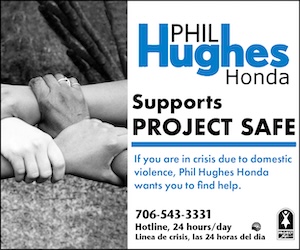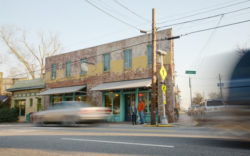BikeAthens attends a lot of public meetings. One of the most frequent complaints we hear concerns speeding traffic—drivers zipping through neighborhoods without care for people walking, kids playing and pets frolicking. We know high speeds are dangerous. How do we make drivers slow down? Enforcement and engineering are the two most effective methods. Unfortunately, Georgia law erects real barriers to speeding enforcement. Engineering remains the most powerful and lasting solution, but is it too expensive?
Police in Georgia cannot issue speeding tickets without obtaining a GDOT radar permit. To obtain a permit, there must be clear sight-lines and a gentle slope (less than 7 percent). Given Athens’ topography and neighborhood street design, these requirements make it difficult, if not impossible, to obtain radar permits in many neighborhoods or even on campus.
Additionally, due to state laws further regulating the use of radar devices, many jurisdictions will not ticket drivers unless they are driving 10 miles per hour over the speed limit. These restrictions make speeding difficult to enforce in many neighborhoods. In others, they raise the effective speed limit by 10 mph. When it comes to enforcement, many “low-speed” Athens streets have effective (and perhaps unenforceable) speed limits around 40 mph.
In place of enforcement, engineering becomes an even more valuable tool to prevent unsafe driving. We can easily engineer our streets to only allow safe, comfortable neighborhood speeds. Both the Athens-Clarke County director of transportation and the city manager have recently made public comments identifying engineering as the best solution for traffic safety. At the same time, they have both wondered if engineered solutions are too expensive. Short answer: No. Engineered traffic calming is inexpensive in the context of street improvements.
In 2011, BikeAthens made a pamphlet, “Traffic Calming Solutions for Athens-Clarke County: Implementing the Neighborhood Traffic Management Program for Safe Streets in Your Neighborhood.” At the time, the ACC budget allocated money for neighborhood traffic calming. The suggested fixes—traffic circles, center median islands, chicanes, neck-downs, bulb-outs and others—range from $1,000–$30,000. When compared to the cost of say, a speed-limit sign, such designs may seem expensive. When compared to the cost of other common transportation projects, these elegant solutions are dirt cheap.
For example, a simple “walk” signal can cost $1,500. An overhead flashing light on Prince Avenue was going to cost $20,000. Road repaving can cost in excess of $200,000 (depending on the length and width of the street). Road widening or reconstruction costs well over $2 million. These last two we often consider fixed costs, which we must put in the budget. In context of such high costs, adding a $30,000 median island, which can reduce pedestrian crashes by up to 46 percent, is a steal. The rhetorical question becomes: If we say a $200,000 resurfacing is a must-have, how do we value preventing deaths and serious injury? Is $30,000 truly cost-prohibitive?
BikeAthens would gladly see Athens forgo or delay an expensive road repaving or reconstruction to install needed traffic calming in all our neighborhoods. (We keep thinking of how the widened Olympic Drive allows people to speed onto the Loop, but also separates East Athens Community Center from Trail Creek Park.) To keep our kids safe, to keep people walking safe, to keep people biking safe, reasonably priced and effective traffic calming solutions should not be taken out of context and labeled “cost-prohibitive.” They should be regular operating expenses.
Tyler Dewey is the executive director of BikeAthens.
Like what you just read? Support Flagpole by making a donation today. Every dollar you give helps fund our ongoing mission to provide Athens with quality, independent journalism.







